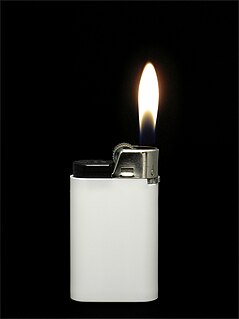 W
WFire making, fire lighting or fire craft is the process of artificially starting a fire. It requires completing the fire triangle, usually by heating tinder above its autoignition temperature.
 W
WThis is an alphabetized glossary of terms pertaining to lighting fires, along with their definitions. Firelighting is the process of starting a fire artificially. Fire was an essential tool in early human cultural development. The ignition of any fire, whether natural or artificial, requires completing the fire triangle, usually by initiating the combustion of a suitably flammable material.
 W
WAmadou is a spongy material derived from Fomes fomentarius and similar fungi that grow on the bark of coniferous and angiosperm trees, and have the appearance of a horse's hoof. It is also known as the "tinder fungus" and is useful for starting slow-burning fires. The fungus must be removed from the tree, the hard outer layer scraped off, and then thin strips of the inner spongy layer cut for use as tinder.
 W
WA fire piston, sometimes called a fire syringe or a slam rod fire starter, is a device of ancient Southeast Asian origin which is used to kindle fire. It uses the principle of the heating of a gas by rapid and adiabatic compression to ignite a piece of tinder, which is then used to set light to kindling.
 W
WFlint is a sedimentary cryptocrystalline form of the mineral quartz, categorized as the variety of chert that occurs in chalk or marly limestone. Flint was widely used historically to make stone tools and start fires.
 W
WA lighter is a portable device which generates a flame, and can be used to ignite a variety of items, such as cigarettes, gas stoves, fireworks, candles or campfire. It consists of a metal or plastic container filled with a flammable liquid or compressed gas, a means of ignition to produce the flame, and some provision for extinguishing the flame. Alternatively, a lighter can be powered by electricity, using an electric arc or heating element to ignite the target.
 W
WA match is a tool for starting a fire. Typically, matches are made of small wooden sticks or stiff paper. One end is coated with a material that can be ignited by frictional heat generated by striking the match against a suitable surface. Wooden matches are packaged in matchboxes, and paper matches are partially cut into rows and stapled into matchbooks. The coated end of a match, known as the match "head", consists of a bead of active ingredients and binder; often colored for easier inspection. There are two main types of matches: safety matches, which can be struck only against a specially prepared surface, and strike-anywhere matches, for which any suitably frictional surface can be used.
 W
WA punk is a smoldering stick used for lighting firework fuses. It is safer than a match or a lighter because it can be used from a greater distance and does not use an open flame. They are made of bamboo and a brown coating of compressed sawdust. Punks often resemble sticks of incense, and in some countries actual incense sticks are used in a similar fashion. Punks are sold at nearly all firework stands and many stands will include them for free with a purchase.
 W
WThe mineral pyrite, or iron pyrite, also known as fool's gold, is an iron sulfide with the chemical formula FeS2 (iron (II) disulfide). Pyrite is the most abundant sulfide mineral.
 W
WA tinderbox, or patch box, is a container made of wood or metal containing flint, firesteel, and tinder, used together to help kindle a fire. A tinderbox might also contain sulfur-tipped matches.